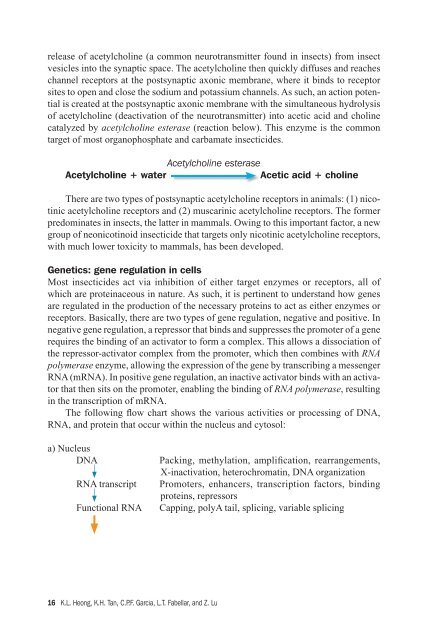Research Methods in Toxicology and Insecticide Resistance ...
Research Methods in Toxicology and Insecticide Resistance ...
Research Methods in Toxicology and Insecticide Resistance ...
You also want an ePaper? Increase the reach of your titles
YUMPU automatically turns print PDFs into web optimized ePapers that Google loves.
elease of acetylchol<strong>in</strong>e (a common neurotransmitter found <strong>in</strong> <strong>in</strong>sects) from <strong>in</strong>sect<br />
vesicles <strong>in</strong>to the synaptic space. The acetylchol<strong>in</strong>e then quickly diffuses <strong>and</strong> reaches<br />
channel receptors at the postsynaptic axonic membrane, where it b<strong>in</strong>ds to receptor<br />
sites to open <strong>and</strong> close the sodium <strong>and</strong> potassium channels. As such, an action potential<br />
is created at the postsynaptic axonic membrane with the simultaneous hydrolysis<br />
of acetylchol<strong>in</strong>e (deactivation of the neurotransmitter) <strong>in</strong>to acetic acid <strong>and</strong> chol<strong>in</strong>e<br />
catalyzed by acetylchol<strong>in</strong>e esterase (reaction below). This enzyme is the common<br />
target of most organophosphate <strong>and</strong> carbamate <strong>in</strong>secticides.<br />
Acetylchol<strong>in</strong>e esterase<br />
Acetylchol<strong>in</strong>e + water Acetic acid + chol<strong>in</strong>e<br />
There are two types of postsynaptic acetylchol<strong>in</strong>e receptors <strong>in</strong> animals: (1) nicot<strong>in</strong>ic<br />
acetylchol<strong>in</strong>e receptors <strong>and</strong> (2) muscar<strong>in</strong>ic acetylchol<strong>in</strong>e receptors. The former<br />
predom<strong>in</strong>ates <strong>in</strong> <strong>in</strong>sects, the latter <strong>in</strong> mammals. Ow<strong>in</strong>g to this important factor, a new<br />
group of neonicot<strong>in</strong>oid <strong>in</strong>secticide that targets only nicot<strong>in</strong>ic acetylchol<strong>in</strong>e receptors,<br />
with much lower toxicity to mammals, has been developed.<br />
Genetics: gene regulation <strong>in</strong> cells<br />
Most <strong>in</strong>secticides act via <strong>in</strong>hibition of either target enzymes or receptors, all of<br />
which are prote<strong>in</strong>aceous <strong>in</strong> nature. As such, it is pert<strong>in</strong>ent to underst<strong>and</strong> how genes<br />
are regulated <strong>in</strong> the production of the necessary prote<strong>in</strong>s to act as either enzymes or<br />
receptors. Basically, there are two types of gene regulation, negative <strong>and</strong> positive. In<br />
negative gene regulation, a repressor that b<strong>in</strong>ds <strong>and</strong> suppresses the promoter of a gene<br />
requires the b<strong>in</strong>d<strong>in</strong>g of an activator to form a complex. This allows a dissociation of<br />
the repressor-activator complex from the promoter, which then comb<strong>in</strong>es with RNA<br />
polymerase enzyme, allow<strong>in</strong>g the expression of the gene by transcrib<strong>in</strong>g a messenger<br />
RNA (mRNA). In positive gene regulation, an <strong>in</strong>active activator b<strong>in</strong>ds with an activator<br />
that then sits on the promoter, enabl<strong>in</strong>g the b<strong>in</strong>d<strong>in</strong>g of RNA polymerase, result<strong>in</strong>g<br />
<strong>in</strong> the transcription of mRNA.<br />
The follow<strong>in</strong>g fl ow chart shows the various activities or process<strong>in</strong>g of DNA,<br />
RNA, <strong>and</strong> prote<strong>in</strong> that occur with<strong>in</strong> the nucleus <strong>and</strong> cytosol:<br />
a) Nucleus<br />
DNA Pack<strong>in</strong>g, methylation, amplifi cation, rearrangements,<br />
X-<strong>in</strong>activation, heterochromat<strong>in</strong>, DNA organization<br />
RNA transcript Promoters, enhancers, transcription factors, b<strong>in</strong>d<strong>in</strong>g<br />
prote<strong>in</strong>s, repressors<br />
Functional RNA Capp<strong>in</strong>g, polyA tail, splic<strong>in</strong>g, variable splic<strong>in</strong>g<br />
16 K.L. Heong, K.H. Tan, C.P.F. Garcia, L.T. Fabellar, <strong>and</strong> Z. Lu

















